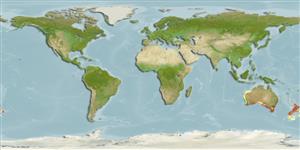>
Centrarchiformes (Basses) >
Latridae (Trumpeters)
Etymology: Latris: Greek, latris = slave (Ref. 45335); lineata: Named for the on the distinctive dark lines running longitudinally across the body..
More on author: Forster.
Environment: milieu / climate zone / depth range / distribution range
Écologie
marin récifal; profondeur 5 - 400 m (Ref. 76767). Temperate; 17°S - 56°S, 13°W - 175°W
Southern Hemisphere: Atlantic Ocean (from Tristan da Cunha and Gough I.); Indian Ocean (Walter Shoals and Saint Paul's I. and Amsterdam Is., Western Australia, across South Australia to southern New South Wales and Tasmania; Pacific Ocean (New Zealand, Bay of Plenty, east to the Chatham Is, and south to the Snares Is. and the subantarctic Auckland Is.). Latris hecateia has been listed in Chile, but records are questionable (Ref. 76767).
Length at first maturity / Taille / Poids / Âge
Maturity: Lm 54.3, range 51 - ? cm
Max length : 120 cm TL mâle / non sexé; (Ref. 9563); poids max. publié: 25.0 kg (Ref. 26433); âge max. reporté: 43 années (Ref. 53584)
Épines dorsales (Total): 17 - 19; Rayons mous dorsaux (Total): 338; Épines anales 3; Rayons mous anaux: 26 - 30; Vertèbres: 37. This species can be distinguished from all other latrids and cheilodactylids (and most percoids) by having anal fin soft rays 26-30; vertebrae 16+21 = 37; a striped body colour pattern comprising three dark bands running longitudinally on the upper body and onto the opercular series and head, with a broader faint band on the flank and a narrow dorsal median band running along the nape and head in front of the dorsal fin (Ref. 76767).
Adults apparently prefer broken rocky reefs, rich in 'coral' and other invertebrate life. Reported to be frequently found over rocky places, especially narrow channels between two cliffs in fjords of New Zealand. May spawn closer to shore (Ref. 9563) but probably in areas of deeper waters, otherwise they seem to migrate offshore to spawn (Ref. 85801). Collected by bottom trawls, dropline, and rod and line (Ref. 76767). In Australia, adults are found over rocky reefs at depths from 5 to 300 m (Ref. 53584).
Females are multiple spawners with group synchronous oocyte development (Ref. 95206).
Roberts, C.D., 2003. A new species of trumpeter (Teleostei; Percomorpha; Latridae) from the central South Pacific Ocean, with a taxonomic review of the striped trumpeter Latris lineata. J. R. Soc. N. Z. 33(4):731-754. (Ref. 76767)
Statut dans la liste rouge de l'IUCN (Ref. 130435)
Menace pour l'homme
Harmless
Utilisations par l'homme
Pêcheries: commercial; Aquaculture: expérimental
Plus d'informations
RéférencesAquacultureProfil d'aquacultureSouchesGénétiqueElectrophoresesHéritabilitéPathologiesTraitementNutrientsMass conversion
CollaborateursImagesStamps, Coins Misc.SonsCiguateraVitesseType de nageSurface branchialeOtolithesCerveauxVision
Outils
Articles particuliers
Télécharger en XML
Sources Internet
Estimates based on models
Preferred temperature (Ref.
123201): 10.6 - 21.2, mean 14.9 °C (based on 181 cells).
Phylogenetic diversity index (Ref.
82804): PD
50 = 0.7812 [Uniqueness, from 0.5 = low to 2.0 = high].
Bayesian length-weight: a=0.01349 (0.00825 - 0.02206), b=3.06 (2.91 - 3.21), in cm total length, based on LWR estimates for this species & (Sub)family-body (Ref.
93245).
Niveau trophique (Ref.
69278): 3.5 ±0.2 se; based on size and trophs of closest relatives
Generation time: 15.8 ( na - na) years. Estimated as median ln(3)/K based on 2
growth studies.
Résilience (Ref.
120179): Très faible, temps minimum de doublement de population supérieur à 14 ans (tmax=29-43; tm=5-7; Fec=205,054 (batch)).
Fishing Vulnerability (Ref.
59153): High to very high vulnerability (67 of 100).
